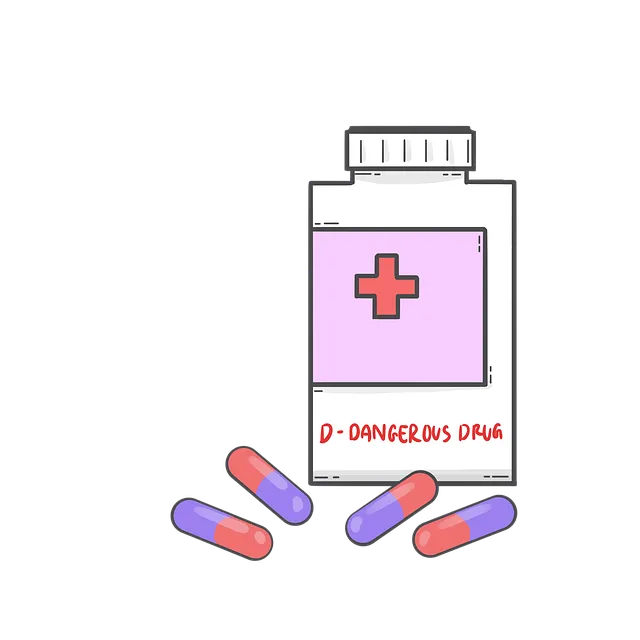Semaglutide, a groundbreaking type 2 diabetes medication, introduces a flexible, personalized dosing strategy that begins with a low initial dose. This approach allows patients' bodies to adjust and minimizes potential side effects like nausea. By gradually increasing the dose based on individual tolerance, healthcare providers achieve effective glycemic control while fostering patient adherence and long-term success in managing type 2 diabetes and weight loss. The "low starting dose escalating as tolerated" method is a game-changer, offering significant improvements over fixed-dose regimens and enhancing quality of life for individuals with metabolic disorders.
Semaglutide, a groundbreaking medication, offers a novel approach to weight management with its unique properties. This article explores the strategic concept of low starting dose escalating as tolerated (LSD-EAT) for semaglutide therapy. LSD-EAT involves initiating treatment with a minimal dose and gradually increasing it based on patient tolerance, providing significant benefits in weight reduction compared to traditional regimes. We delve into patient selection, implementation guidelines, side effect management, real-world success stories, and future research directions, shedding light on the potential of semaglutide dosing for effective weight management.
Understanding Semaglutide and Its Unique Properties

Semaglutide is a groundbreaking medication that has revolutionized diabetes management, particularly in the treatment of type 2 diabetes. Its unique properties set it apart from other glucose-lowering agents. One of its key features is its ability to mimic a natural hormone called GLP-1 (glucagon-like peptide-1), which is produced by the body in response to food intake. This imitation enables semaglutide to enhance insulin secretion when blood sugar levels rise, while also suppressing glucagon release, leading to improved glycemic control.
The medication’s dosing strategy is tailored to individual patient needs, starting with a low initial dose and gradually increasing as tolerated. This approach ensures that the body can adjust to the drug’s effects, minimizing potential side effects associated with rapid changes in blood sugar levels. The flexible semaglutide dosing allows for personalized treatment, making it an effective and well-tolerated option for many individuals living with diabetes.
The Concept of Low Starting Dose Escalating as Tolerated

The concept of low starting dose escalating as tolerated is a tailored approach in pharmaceutical therapy, particularly relevant for medications like semaglutide, a glucagon-like peptide-1 (GLP-1) receptor agonist used to manage type 2 diabetes. This strategy involves initiating treatment with a minimal effective dose and gradually increasing it based on the patient’s individual tolerance and response. By starting low, healthcare providers can closely monitor any adverse effects and adjust the dosage accordingly, ensuring optimal benefits while minimising risks.
This method is especially beneficial for semaglutide, known for its potential nausea and gastrointestinal side effects. A low initial dose allows patients to acclimate to the medication, often leading to better tolerance as the body adjusts. This escalating approach provides a personalised treatment plan, recognising that every patient’s response to medication is unique. It offers a more gradual and precise way to achieve therapeutic goals compared to standard fixed-dose regimens.
Benefits of This Dosing Strategy for Weight Management

Starting with a low dose of semaglutide and gradually increasing as tolerated offers several advantages for weight management. This strategy allows for a gradual adjustment to the medication, making it easier for individuals to tolerate potential side effects, which are common with semaglutide treatment. By starting low, healthcare providers can closely monitor patients’ responses, ensuring the dose is optimized without causing discomfort or adverse reactions.
This approach also promotes better patient adherence to the treatment plan. When patients see gradual improvements in their weight and overall health, they become more motivated to continue the therapy. The escalating nature of this strategy enables a personalized journey towards weight management goals, catering to individual needs and preferences, ultimately leading to long-term success.
How It Differs from Traditional Weight Loss Medication Regimes

Low starting dose escalating as tolerated is a unique approach to weight loss treatment, particularly in comparison to traditional medication regimes. Unlike typical prescription pills that often begin with a standard dose and may lead to side effects, this method introduces semaglutide at a minimal initial amount, allowing for gradual adjustment based on individual response. This strategy ensures a more personalized journey, where the body can adapt steadily.
The concept behind this approach is to mimic natural weight loss processes. By starting low and escalating, it mirrors how our bodies gradually adjust to dietary changes and exercise routines. This method also reduces the risk of adverse reactions commonly associated with abrupt dosing, making it an appealing alternative for those seeking a more gentle and tailored path to achieving their weight management goals.
Patient Selection Criteria for Semaglutide Therapy

When considering semaglutide therapy, patient selection is crucial for optimal outcomes and safety. Ideal candidates are those with type 2 diabetes who have not achieved their glycaemic goals despite optimal lifestyle modifications and previous medication trials. This often includes patients with a Body Mass Index (BMI) of 27 or higher, or those with comorbidities like cardiovascular disease or non-alcoholic steatohepatitis (NASH).
The choice of starting dose for semaglutide is individualised, taking into account patient characteristics and baseline glycaemic control. A low initial dose, typically 0.25 mg once weekly, allows for gradual titration up to the recommended maintenance dose of 1 mg or higher, as tolerated. This stepwise approach minimises the risk of adverse effects while maximising the potential for glycemic improvement.
Implementation: Step-by-Step Guide to Dose Escalation

Implementing a low starting dose escalating as tolerated strategy for semaglutide treatment involves careful, structured steps. Begin by prescribing an initial low dose to minimize potential side effects and patient discomfort. This initial phase allows the body to adjust gradually to the medication. After this acclimatization period, evaluate the patient’s response – assessing symptoms, blood glucose levels, and any adverse reactions. If well-tolerated, incrementally increase the semaglutide dose according to predefined intervals. This step-by-step approach ensures a safe and effective titration process.
Continue escalating the dose until the target is reached or side effects become pronounced. Regular monitoring is key – routine check-ups enable quick intervention if necessary. Patients should be educated on recognizing and reporting symptoms, fostering an open dialogue for optimal treatment adjustment. This guided escalation method not only improves patient adherence but also enhances long-term outcomes in managing conditions like type 2 diabetes.
Monitoring and Managing Side Effects During Treatment

During treatment with low starting doses of semaglutide, escalating as tolerated, it’s crucial to monitor and manage side effects proactively. Regular check-ins with healthcare providers are essential to assess any adverse reactions, particularly during the initial stages when the body adjusts to the medication. Common side effects associated with semaglutide dosing may include gastrointestinal issues such as nausea, vomiting, or diarrhea, which often improve over time.
Effective management involves open communication between patients and healthcare teams. Dose adjustments can be made based on individual tolerability, ensuring a personalized approach. By closely monitoring side effects, healthcare providers can guide patients to maintain an optimal semaglutide dosing regimen, enhancing treatment adherence and outcomes while minimizing disruptions caused by adverse reactions.
Real-World Success Stories: Clinical Trials and Patient Outcomes

In real-world settings, the low starting dose escalating as tolerated approach with semaglutide dosing has shown remarkable success in clinical trials and patient outcomes. These studies highlight how this strategy can effectively manage type 2 diabetes, often leading to significant improvements in glycemic control while minimizing adverse effects. Patients have reported reduced hunger and better satiety, contributing to improved quality of life despite the initial low doses. As the dosage escalates according to individual tolerance, many individuals achieve their target HbA1c levels with minimal side effects, making this approach a game-changer in diabetes management.
The patient journey with semaglutide dosing often involves a period of adjustment, but the escalating nature allows for a tailored and gradual process. This not only increases adherence to treatment but also fosters trust between patients and healthcare providers. Real-world data indicate that this method can result in sustained blood sugar control, weight loss, and improved cardiovascular risk profiles—all without compromising patient comfort or quality of life.
Future Perspectives and Research Directions

Future research and clinical trials will play a pivotal role in further exploring the benefits and optimal administration strategies of low-starting, escalating semaglutide dosing regimens. As this therapeutic approach gains traction, studies could delve into personalized medicine aspects, tailoring dosages based on individual patient characteristics, such as age, weight, or comorbidities. This precise approach may enhance treatment efficacy and minimize adverse effects.
Additionally, long-term safety and sustainability of semaglutide’s escalating doses should be a key focus. Observational studies could provide valuable insights into the real-world effectiveness and potential long-term outcomes. Furthermore, investigating the mechanism of action at different dose levels might reveal novel therapeutic opportunities not only for diabetes management but also for other metabolic disorders, thus expanding the future clinical applications of semaglutide dosing strategies.
